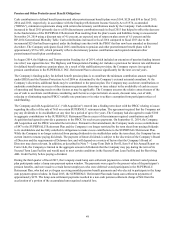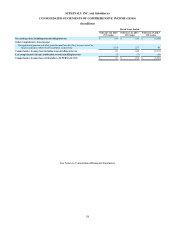Albertsons 2015 Annual Report Download - page 53
Download and view the complete annual report
Please find page 53 of the 2015 Albertsons annual report below. You can navigate through the pages in the report by either clicking on the pages listed below, or by using the keyword search tool below to find specific information within the annual report.
51
contributions to these plans, it could trigger a partial or complete withdrawal that would require the Company to fund its
proportionate share of a plan’s unfunded vested benefits.
Based on the assessment of the most recent information available, the Company believes that most of the multiemployer plans
to which it contributes are underfunded. The Company is only one of a number of employers contributing to these plans and the
underfunding is not a direct obligation or liability of the Company. However, the Company has attempted, as of February 28,
2015, to estimate its “proportionate share” of the underfunding of multiemployer plans to which the Company contributes,
based on the ratio of its contributions to the total of all contributions to these plans in a year. As of February 28, 2015, the
estimate of the Company’s share of the underfunding of multiemployer plans to which it contributes was $447, pre-tax, or
$308, after-tax. This represents a decrease in the estimated proportionate share of the underfunding of approximately $8, pre-
tax, or $6, after-tax, as of February 28, 2015, compared to February 22, 2014. The decrease in the Company’s proportionate
share of underfunding is attributable to the changes in contribution rates resulting from renegotiated collective bargaining
agreements, higher than anticipated return on assets and benefit payments in relation to contributions received. The estimate is
based on the most current information available to the Company including actuarial evaluations and other data, and may be
outdated or otherwise unreliable. The Company’s proportionate share of underfunding described above is an estimate and could
change based on the results of collective bargaining efforts, investment returns on the assets held in the plans, actions taken by
trustees who manage the plans’ benefit payments and requirements under the Pension Protection Act of 2006, the
Multiemployer Pension Reform Act and Section 412(e) of the Internal Revenue Code.
Company contributions can fluctuate from year to year due to store closures and reductions in headcount. In fiscal 2016, the
Company expects to contribute approximately $35 to $45 to the multiemployer pension plans, subject to the outcome of
collective bargaining and capital market conditions. Furthermore, if the Company were to significantly reduce contributions,
exit certain markets or otherwise cease making contributions to these plans, it could trigger a partial or complete withdrawal
that would require the Company to record a withdrawal liability. Any withdrawal liability would be recorded when it is
probable that a liability exists and can be reasonably estimated, in accordance with Accounting Standards.
The Company also makes contributions to multiemployer health and welfare plans in amounts set forth in the related collective
bargaining agreements. A small minority of collective bargaining agreements contain reserve requirements that may trigger
unanticipated contributions resulting in increased healthcare expenses. If these healthcare provisions cannot be renegotiated in
a manner that reduces the prospective healthcare cost as the Company intends, the Company’s Selling and administrative
expenses could increase in the future.
CONTRACTUAL OBLIGATIONS
The following table represents the Company’s significant contractual obligations as of February 28, 2015:
Payments Due Per Period
Total
Fiscal
2016
Fiscal
2017-2018
Fiscal
2019-2020 Thereafter
Contractual obligations(1)(2):
Long-term debt(3) $ 2,497 $ 10 $ 308 $ 1,429 $ 750
Interest on long-term debt(4) 693 143 251 177 122
Operating leases(5) 582 113 190 128 151
Capital leases(6) 310 42 76 68 124
Purchase obligations(7) 244 161 72 11 —
Self-insurance obligations(8) 99 30 32 14 23
Total contractual obligations $ 4,425 $ 499 $ 929 $ 1,827 $ 1,170
(1) Contractual obligations payments due per period presented here exclude the Company’s required funding of its pension
and postretirement benefit obligations, which totaled $169 for fiscal 2015, because the timing of future payments beyond
fiscal 2016 cannot be reasonably determined. Pension and postretirement benefit obligations were $610 as of February 28,
2015. The Company expects to contribute $55 to $65 to pension and postretirement benefit plans during fiscal 2016.
(2) Unrecognized tax benefits, which totaled $94 as of February 28, 2015, were excluded from the contractual obligations
table because an estimate of the timing of future tax settlements cannot be reasonably determined.
(3) Long-term debt amounts exclude any original issue discounts. Long-term debt payments due per period for fiscal 2017
through thereafter exclude any Excess Cash Flow prepayments under the provisions of the Secured Term Loan Facility
because the timing of future prepayment amounts, if any, are not reasonably estimable as of February 28, 2015.
























